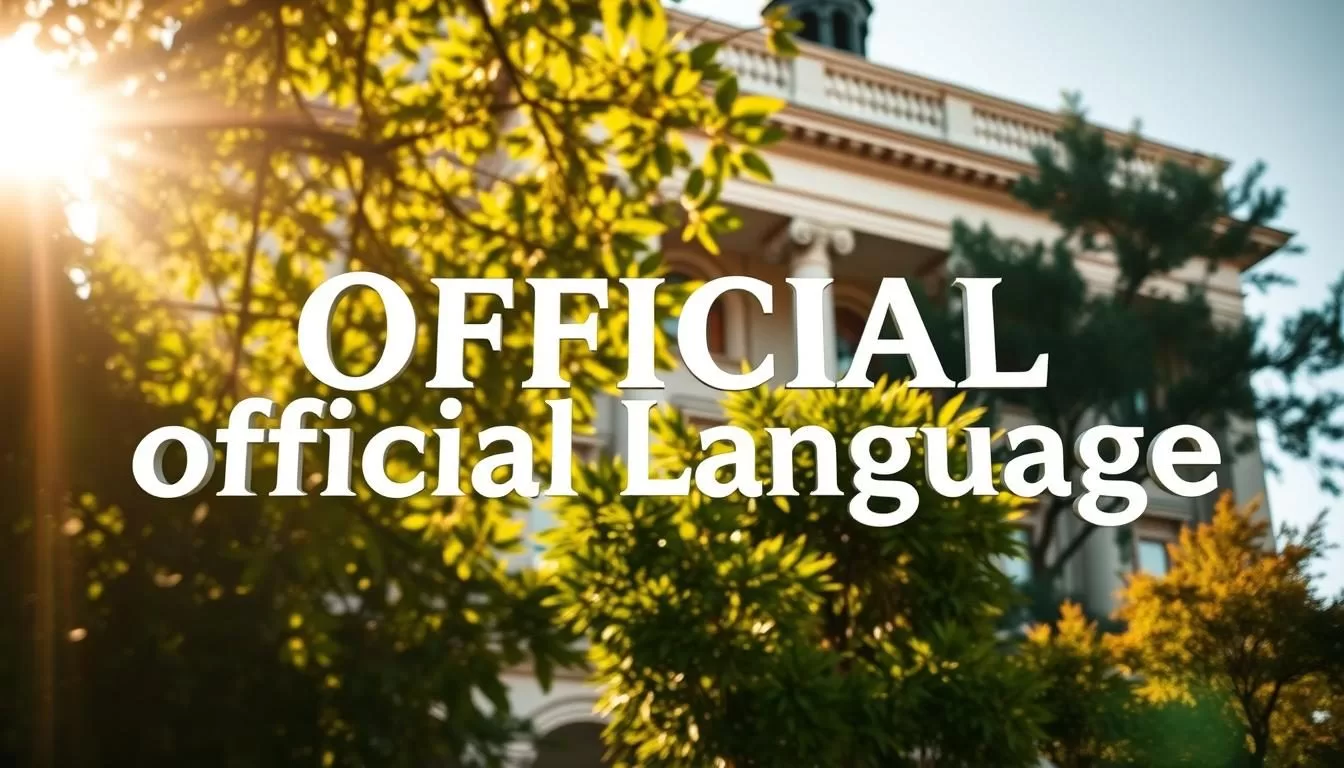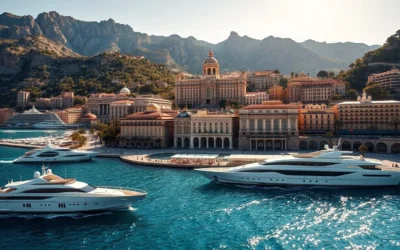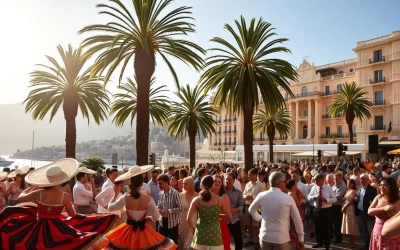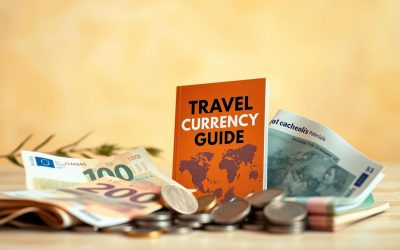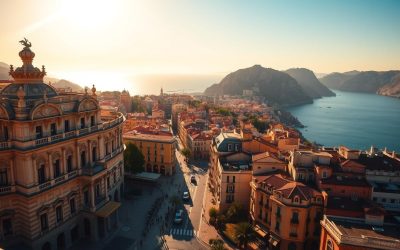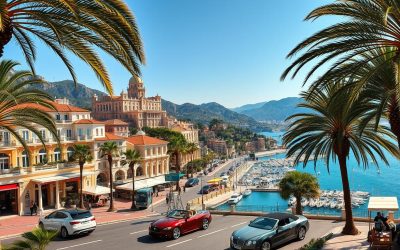✓ Tours & Activities ✓ Tours & Activities
Monaco is a unique country known for its rich cultural tapestry. French is the official language, used in government, business, and education. This reflects the deep historical ties between Monaco and France.
Beyond French, other languages like Italian, English, and Monégasque add to the nation’s diversity. Italian is spoken by a significant portion of the population, while English is common among the Anglophone community.
Monégasque, the traditional language, was once at risk of extinction. Today, it is being revived through education, preserving Monaco’s heritage. This blend of languages highlights the world influence of this small yet vibrant country.
Introduction: Discover Monaco’s Linguistic Landscape
Despite its compact size, this country is a hub of linguistic diversity. With an area of just 2.08 km², it’s the second smallest sovereign state globally. Yet, it’s home to nearly 39,000 residents, making it one of the most densely populated places on Earth.
Everyday life here is a blend of cultures and languages. French dominates as the primary mode of communication, but Italian and English are also widely used. This mix reflects the diverse backgrounds of its population.
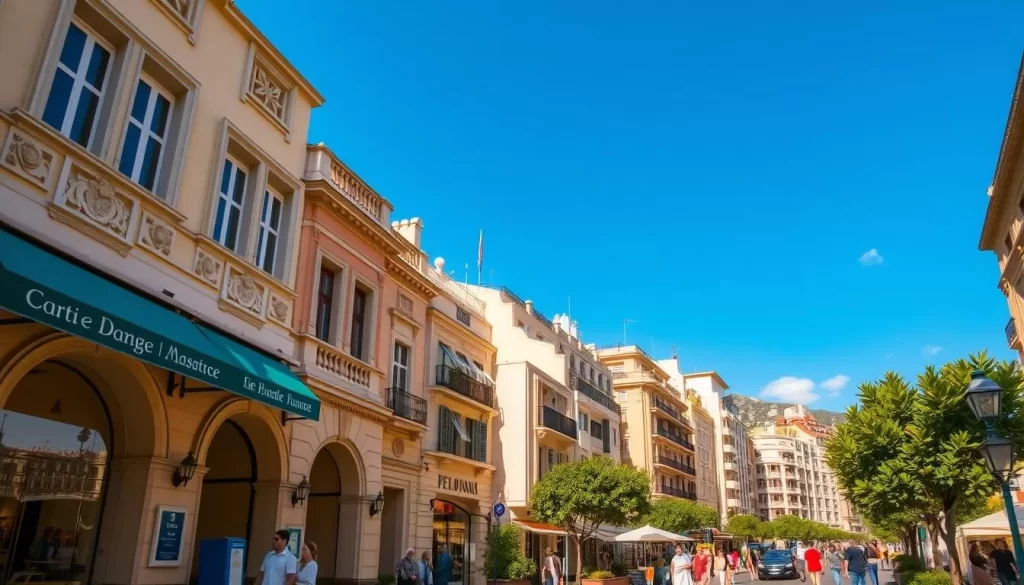
Who are the people living here? A significant portion includes French citizens, while others trace their roots to Italy or other parts of the world. This multicultural environment shapes the way language is woven into daily interactions.
Below is a quick overview of key facts about this fascinating nation:
| Category | Details |
|---|---|
| Total Area | 2.08 km² |
| Population | 38,367 |
| Population Density | 18,446 people/km² |
| Primary Language | French |
| Other Common Languages | Italian, English, Monégasque |
This unique blend of size, population, and culture makes it an intriguing example of how language shapes a nation’s identity. As you explore further, you’ll see how this small yet vibrant country thrives on its linguistic richness.
French: The Official Language of Monaco
French plays a central role in shaping the identity of this vibrant nation. As the official language, it is deeply embedded in government, business, and media. This reflects the strong cultural and historical ties between this country and France.
Government, Business, and Media in French
In government administration, French is the primary mode of communication. Official documents, laws, and public announcements are all conducted in this language. This ensures clarity and consistency in governance.
The business sector also relies heavily on French. From corporate meetings to financial transactions, it is the preferred medium for professional interactions. This facilitates smooth operations and strengthens economic ties with French-speaking regions.
Everyday Communication and Social Life
Beyond formal settings, French enriches daily life. It is the go-to language for social interactions, whether at cafes, markets, or community events. This widespread use fosters a sense of unity among residents.
Media outlets, including newspapers, television, and radio, predominantly use French. This ensures that the influence of the language extends to all aspects of culture and information dissemination.
Traditional Heritage: Monégasque and Occitan Languages
Monaco’s linguistic heritage is a blend of tradition and modernity. Beyond French, the nation takes pride in its traditional dialects, Monégasque and Occitan. These languages are not just modes of communication but symbols of cultural identity.
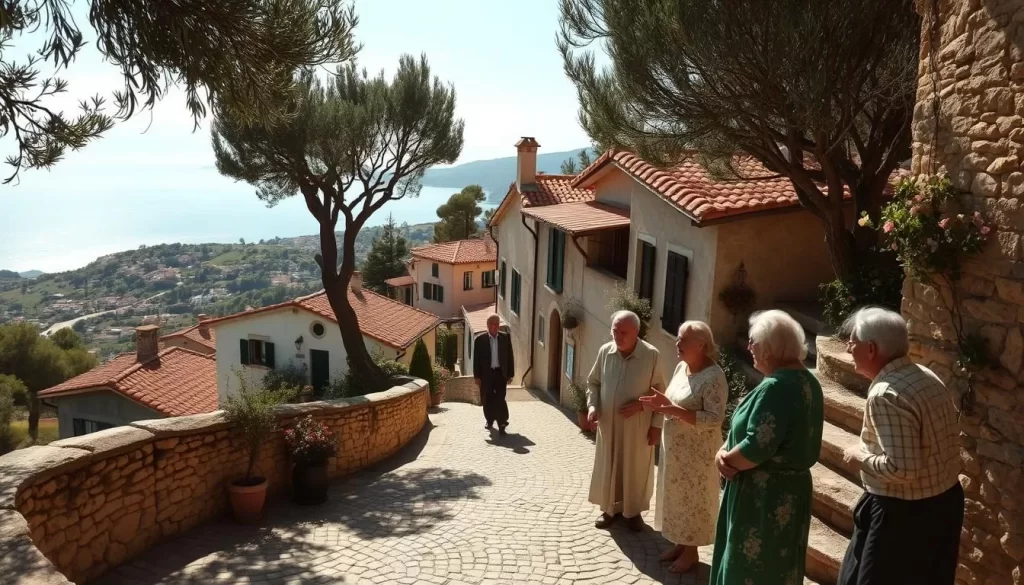
Revival Efforts for Monégasque
Monégasque, once on the brink of extinction, has seen a remarkable revival. In 1976, it became a compulsory subject in schools, ensuring its survival for future generations. Today, efforts by the Commission for the Monégasque Language continue to promote its study and use.
Despite these efforts, Monégasque is rarely spoken outside classrooms. This highlights the challenge of balancing formal education with everyday usage.
Preserving Occitan Traditions
Occitan, another traditional dialect, holds cultural significance despite its smaller number of speakers. Classified as Severely Endangered by UNESCO, it remains a vital part of Monaco’s heritage.
Preservation initiatives focus on educating younger generations about Occitan’s value. These efforts ensure that this language continues to enrich the nation’s cultural fabric.
Monaco: Official and widely spoken languages
The linguistic identity of this small yet vibrant country is shaped by its official language and traditional dialects. French dominates as the primary mode of communication, reflecting its deep-rooted influence in governance and daily life.
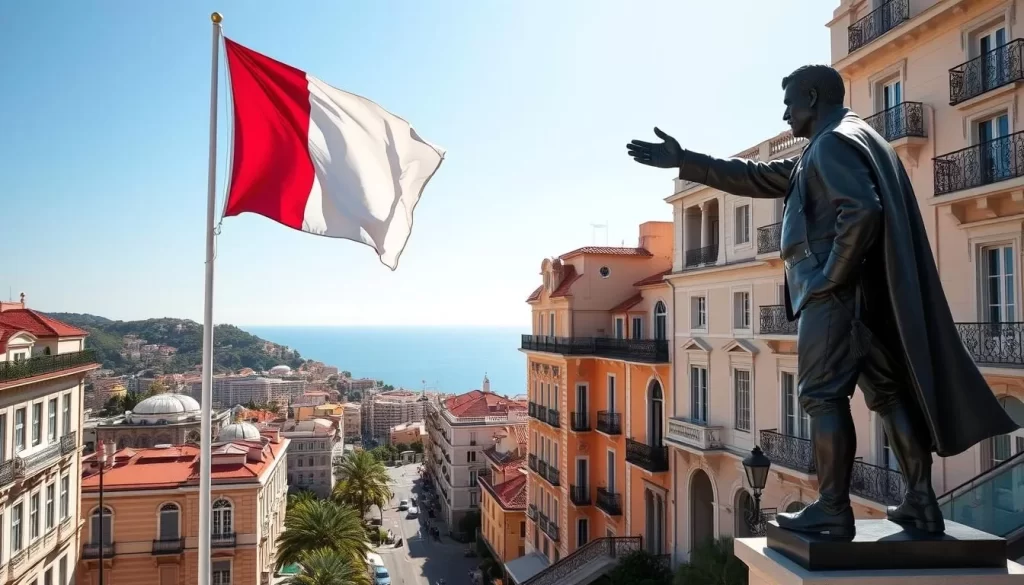
Beyond French, Monégasque holds a special place in the nation’s heritage. Once at risk of fading away, it is now taught in schools and promoted by organizations like the Commission for the Monégasque Language. This revival ensures that the language remains a symbol of cultural pride.
In public spaces, you’ll notice street signs in both French and Monégasque, showcasing the country’s commitment to preserving its linguistic roots. This blend of modern and traditional elements highlights the unique character of this nation.
Everyday interactions are enriched by this linguistic diversity. Whether in cafes, markets, or community events, the use of multiple languages fosters a sense of unity and connection among residents.
This interplay of languages not only defines the country’s identity but also strengthens its cultural fabric. It’s a testament to how language can bridge history and modernity, creating a vibrant and inclusive society.
The Influence of Italian and English in Monaco
Italian and English add unique flavors to the cultural mix in this small yet vibrant nation. These languages reflect the diverse roots of the population and their global connections. While French dominates daily life, Italian and English enrich the linguistic landscape.
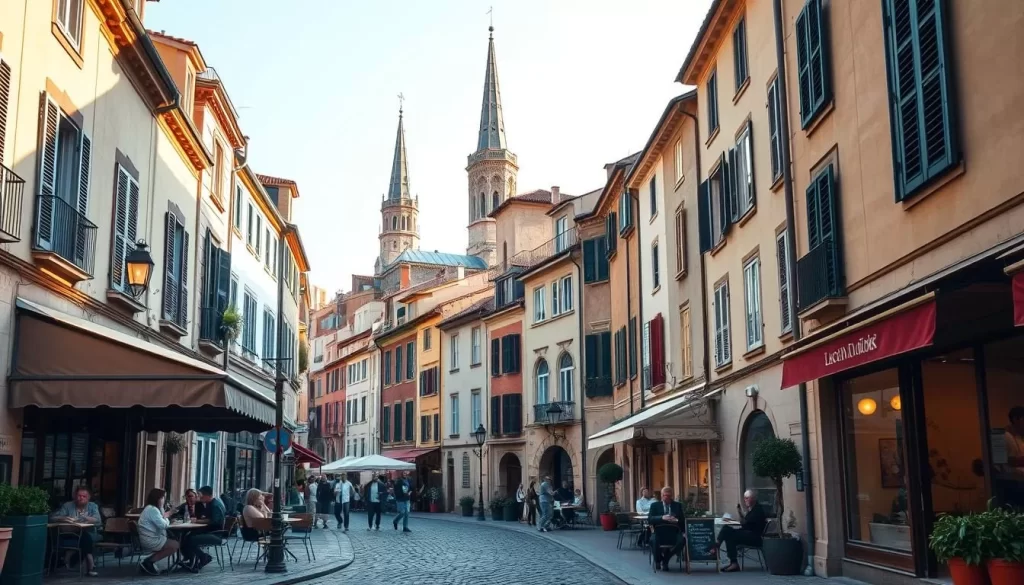
Italian Roots and Community Impact
Italian has deep historical ties here, thanks to the proximity to Italy and the significant Italian-speaking resident community. Many families trace their roots back to Italy, and this heritage is celebrated in cultural events and traditions.
In everyday life, Italian is often heard in cafes, markets, and social gatherings. This language fosters a sense of belonging among the Italian community, preserving their identity while contributing to the nation’s diversity.
The Role of English in Modern Communication
English has gained prominence due to globalization and the presence of expatriates. It’s widely used in business, tourism, and education, making it a key language for international communication.
For many residents, English is a bridge to the global community. Whether you’re a tourist or a person working here, English ensures smooth interactions and connections with people from around the world.
This blend of Italian and English reflects the balance between tradition and modernity. It’s a testament to how language can shape a nation’s identity while embracing global influence.
To learn more about the cultural diversity of this region, visit this link.
Language and Culture: Bridging History and Modernity
The blend of history and modernity in this region’s linguistic practices offers a fascinating glimpse into its cultural evolution. From its historical roots to its current multilingual interactions, the language scene here is a testament to its rich heritage and global connections.
Historical Influences on Monaco’s Speech
French, as the dominant language, reflects centuries of historical ties with France. Its influence extends beyond borders, with French being spoken on six continents and serving as one of the procedural languages of the EU. This historical backdrop has shaped the linguistic identity of the region, blending tradition with global influence.
Monégasque, the traditional dialect, has also played a crucial role in preserving cultural heritage. Efforts to revive and teach Monégasque in schools highlight the importance of maintaining this connection to the past.
Modern Multilingual Interactions
Today, the region thrives on its multilingual environment. Italian and English are widely spoken, reflecting the diverse backgrounds of its residents. This linguistic diversity not only enriches daily life but also supports the local economy by attracting tourists and international businesses.
Global trends have further influenced language usage here. English, in particular, has become a bridge to the world, facilitating communication in business, tourism, and education. This modern multilingualism ensures the region remains connected to global developments while preserving its unique identity.
To learn more about the cultural heritage of Monaco, visit this link.
Multilingual Education and Revival Initiatives
Education in this region plays a key role in preserving cultural identity. Schools are actively integrating traditional dialects into their curricula, ensuring that younger generations stay connected to their heritage.
One of the most notable efforts is the revival of Monégasque, a traditional dialect once at risk of fading away. Since 1976, it has been a compulsory subject in schools, helping to keep this language alive.
Integrating Traditional Dialects in Schools
Educational programs are designed to immerse students in both modern and traditional practices. This approach fosters multilingual fluency while honoring cultural roots. For example, bilingual programs in French and English are increasingly popular, with around 30% of students enrolled.
Government initiatives also play a crucial role. Projects aimed at preserving linguistic heritage ensure that traditional dialects remain a vibrant part of daily life. These efforts include:
- Developing specialized teaching materials.
- Organizing cultural events to celebrate local dialects.
- Training educators to effectively teach these languages.
To learn more about the revival of Monégasque, explore this insightful resource.
By blending tradition with modern education, these initiatives ensure that cultural heritage remains a vital part of the community. They also prepare students to thrive in a globalized world, where multilingualism is an invaluable skill.
Languages in Business, Tourism, and Daily Life
In this vibrant region, languages shape more than just communication—they drive economic growth and global connections. Whether in business meetings or tourist hotspots, the ability to speak multiple languages fosters seamless interactions and opens doors to new opportunities.
Facilitating Global Connectivity
Monte Carlo stands as a prime example of how linguistic diversity enhances global connectivity. With English widely spoken in business circles, it bridges the gap between local and international markets. This makes it easier for companies to collaborate with partners worldwide.
Tourism also thrives on multilingualism. Guided tours in multiple languages ensure visitors feel welcome and informed. This approach not only boosts satisfaction but also encourages repeat visits.
Enhancing Economic Opportunities
The economy here benefits significantly from its multilingual environment. Monte Carlo’s reputation as a global hub attracts investors and entrepreneurs from diverse backgrounds. This influx contributes to a thriving business landscape.
For instance, the Grand Prix de Monaco brings a surge of activity, with businesses adapting to cater to international visitors. This event alone highlights the importance of linguistic flexibility in driving economic success.
To learn more about how languages shape this region’s identity, visit this insightful resource.
Conclusion
This small yet vibrant country thrives on its rich linguistic tapestry. French, as the official language, shapes governance and daily life, while traditional dialects like Monégasque preserve cultural heritage.
With a population of nearly 39,000 in a compact area, the nation’s linguistic diversity reflects its global connections. Italian and English add to this mix, enriching both social interactions and the economy.
Language here is more than communication—it’s a bridge between history and modernity. From street signs to schools, the blend of French, Monégasque, and other tongues highlights the region’s unique identity.
Explore how linguistic diversity shapes nations globally in this insightful resource.
The above is subject to change.
Check back often to TRAVEL.COM for the latest travel tips and deals.
